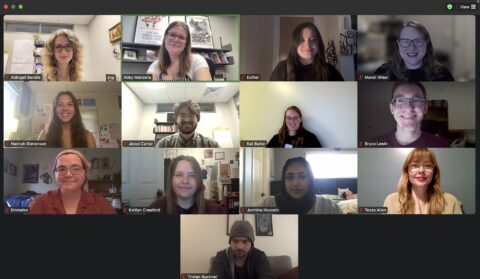
This week, students from Professor Abby Manzella’s Flash Non/Fiction Workshop at Truman State University will read our submission queue. The students—Tessa Allen, Abbigail Bendle, Tristan Buckner, Kat Butler, Jesse Carter, Kaitlyn Crawford, Esther Fox, Emmalee Gilliam, Jasmine Hussain, Bryce Lewin, Hannah Stevenson, and Mandi Wiser—will select three pieces to send directly to our senior editors for consideration. We asked them to answer a few questions about themselves. Read on for their answers!
Tell us a little about yourselves. Who are you? Where are you from?
We are a group of graduate and advanced undergraduate students from Truman State University in a small town in Northeast Missouri. Some of us are creative writing students, some are studying to be teachers, and some are mostly readers looking to explore writing more in depth.
Our previous knowledge of flash is varied with several of us realizing that we have been unknowingly reading flash for many years, and perhaps even writing it. Others have long loved the power of this concise form that gives so much weight to so few words. We hail from farms, small towns, and big cities from throughout Missouri, Illinois, California, as well as some bouncing around in between. Therefore, this course is held online, although some are also taking advantage of campus life in Kirksville. We have pets from cats, dogs, and rabbits to a horse and even a python named Mr. Legs.
What have you been learning about flash in your class? What do you like (or perhaps not like) about it?
We are still in the early days of this course, but we’re learning the power of brevity. We both like and dislike its concision; the brevity makes for a beautiful reading experience but a challenging writing experience. In class we’ve discussed the blurring of the lines between prose and poetry, and played with the incorporation of research. We’ve also talked about the power of lists and the element of honesty in flash nonfiction. Along the way we are considering how to tell a story in a small space with artistry that leaves a mark.
Who are some of your favorite writers (flash or otherwise)?
We read A LOT! Our interests range from Jane Austen to Ocean Vuong. We’ve listed just a few more examples: Louise Erdrich, George Saunders, Ottessa Moshfegh, C.S. Lewis, Edgar Allan Poe, Cormac McCarthy, Stephen King, Lia Purpura, and Percival Everett.
What are some of your favorite flash pieces (fiction or nonfiction)?
For class we read widely through SmokeLong Quarterly (and enjoyed the plenty!), and one piece that affected us was the story of war, loss, and the distance of experiences in S.L. Bailey’s “In November 2017.” Here are several individual recommendations to expand our offering:
Reading Franz Kafka’s “Give it Up” was like someone had taken out my brain to look at it for a moment and then replaced it in my head slightly askew. To be so affecting to my mood in so few words was something I regarded as just short of a miracle.
I loved the quote, “It was no longer possible to tell whether I was human, a ghost, or something else,” from Uyen Phuong Dang’s “Rice,” that blends themes of identity, birth, and nature.
One I recently came across was published by HAD, “The First Snake to Crawl Through the Eye Socket of a Human Skull” by Martyn Pedler. It is a humorous meditation on some serious topics.
Sandra Cisneros’s The House on Mango Street, is a powerful collection of flash-length vignettes about a young girl named Esperanza. I’m excited to dissect the stories in this class.
A hermit-crab piece I really loved is Kristen Arnett’s “Gator Butchering For Beginners.” It has really visceral imagery that carefully alludes to a completely different story behind the gore.
My favorite flash fiction pieces were both published on Wigleaf: “Glass Birds” and “Mantis.” “Glass Birds” packs so much emotion and storyline into so little. The narrator’s characterization develops so quickly that the end pulls on the reader’s heartstrings. “Mantis” tells a short story about a mantis with very human problems but peppered in witty, cutting prose.
Any of Hemingway’s short work like “The Short Happy Life of Francis Macomber” and “Hills Like White Elephants” always seem to unsettle me in the best way.
And several of us are still reflecting on the collection our class just finished reading, Bite by Bite by Aimee Nezhukumatathil. From “Mango” to “Butter” to “Maple Syrup” her descriptions were vivid and her seizing of happiness memorable. Her smart use of almanac qualities and the flash form really made this entertaining personal history of the food a satisfying meal of appetizers!
What do you hope to learn from reading the SmokeLong submission queue?
We’re excited to see what happens behind the scenes at a literary magazine and learn about the process of going through submissions. As writers submitting to journals, as readers, and as future teachers, we’re looking forward to being on the other side for a moment.
We’re also excited to read unpublished work to see what’s being written about right now. We hope not merely to gain a better understanding of flash but also the types of things people want to share – and share in such a condensed way! To write a well-structured story in a small word count means that there’s a focus on “getting to the moment,” which also means that there are many clever ways a writer can arrive there, even through more experimental forms or techniques.
Finally, we’re huge proponents of learning through example, so being able to read other writers’ work will be a great asset. It’s also just encouraging to see real people putting their work out into the world, waiting to see what happens.
Is there anything else you’d like us to know about you?
Whether we are very new to the world of flash or have already embraced the form, we are approaching our study of flash with a genuine curiosity and hunger to understand it, study it, and write some ourselves. Our conversations have thus far been lively, and we’re grateful for the opportunity to talk with you and read submissions!

 The SmokeLong Grand Micro Contest (The Mikey) is now an annual competition celebrating and compensating the best micro fiction and nonfiction online.
The SmokeLong Grand Micro Contest (The Mikey) is now an annual competition celebrating and compensating the best micro fiction and nonfiction online.